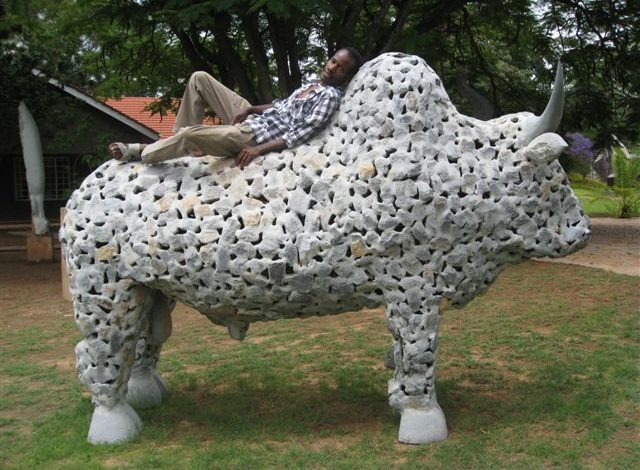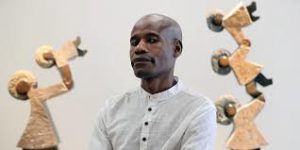Dominic Benhura Profile – A World beater Struggling to make a name at home
Walking Down The Memory Lane - Lest We Forget

Dominic Benhura

By Kamangeni Phiri 14/10/2022
They speak a universal language of happiness, love, playfulness and fun, yet they lack facial features. Girls playing in groups, a child strapped to its mother’s back and a mother playfully swinging her child proudly stand out among hordes of sculptures dotted around the yard.
A feeling of movement brings life to the sculptures, making it appear as if they are mocking the rigidity of the very stone they are carved out of.
Indeed, stone moves in the hands of worldly acclaimed sculptor, Dominic Benhura. The art pieces might lack faces but they still express emotion and motion.
Benhura started making the playful and whimsical pieces around 1996 after realising that his forerunners’ sculptures were melancholic and mostly static.
“I like to show motion, bringing out movement in my pieces. From the movement it creates the impression that the pieces have faces. People love them. Wherever I go, in Asia, Australia or America, my pieces relate very well with everybody because they don’t have faces. It’s just people,” he says.
One such piece with a universal appeal is a sculpture titled Welcome which emits motion and warmth in equal measure. It shows a girl with outstretched arms, apparently ready to embrace the many guests who visit Benhura’s art studio.
Yet most of the artist’s pieces in his early days of sculpting had eyes and mouths. They were beautiful but looked sad, he said. In fact, Benhura could see a lot of sadness in most of the other sculptures’ pieces. He concluded the “problem” was the sculptures’ facial countenance.
“Very few could make them look happy. I removed the eyes first and later the other facial features because I wanted my pieces to exude happiness,” Benhura said.
His subjects, usually mothers and children, exude a sense of pure joy as they stand on display in various stages of play at Benhura’s gallery-cum-workshop in Harare where they have attained immortality.
Its either they are leapfrogging, jumping, or cheering.
In his pieces, Benhura sought to drive home the message that all people were equal and the same around the world.
“People basically engage in the same type of games. When covid- 19 was at its peak, all people had to wear masks regardless of race, tribe or geographic location, to protect themselves against the pandemic yet no animal had to wear one. This shows we are all the same,” he said.
Unlike most artists, Benhura is guided by neither dreams nor ancestral spirits in his work. He applies a scientific approach in his art. He first puts his ideas on paper through sketching the piece he wants to make before going into the hills to look for the appropriate stone.
“There is nothing spiritual really. It is simple art. But I don’t get the sketches to dictate my work. I just let it unfold,” he says.
Benhura was born on October, 1, 1968 in rural Murehwa, northeast of Harare. His father died before his birth, and he was raised by his mother with the help of his paternal aunt.
At the age of six, young Dominic was herding neighbours’ cattle as a way of helping his widowed mother provide for the family.
To pass the time while at the pastures, the boy would engage in clay moulding. This was the start of his illustrious sculpting career.
Dominic enrolled for grade one at Kambarami Primary School where he proved to be a highly intelligent pupil. His family arranged for him to be sent to Harare for better education opportunities in 1979.
In Harare, a 10-year old Dominic enrolled at Tafara Primary School where he continued with his education up to grade seven. He then moved to Tafara 1 High for his four years of secondary education. Benhura passed his ordinary level exams and proceeded to Oriel Girls High for his A’ level. He was among the first group of boys to attend the girls only high school. Benhura briefly studied Math, Biology, Chemistry and Physics, as a prelude to pursuing a degree in medicine at university.
“I only attended A’ level classes just for a term before quitting. I realised that my mother was quite poor and I wanted to help take care of the family. She was a vegetable vendor in Chitungwiza and we were staying in one room with my youngest sister,” said Benhura.
In Tafara, the boy stayed at his uncle’s place while his mother rented a room in the dormitory town of Chitungwiza. Dominic’s uncle had a son, Tapfuma Gutsa, who was and still is, a well-established sculptor.
He used to watch his cousin Tapfuma and other local sculptures carving stones and was fascinated by their work. Dominic offered to polish his cousin’s sculptures and Tapfuma agreed. Within a short time, the boy was carving his own pieces at the age of ten. He utilised small off-cuts, before moving onto large stone.
The established sculptors liked his work and helped market it to people who came to buy their pieces. Benhura sold his first piece at the age of 12 to architects, Michael Pearce and Peter Jackson, who designed Danhiko School and Eastgate Mall.
The piece themed The Spirit of Danhiko is placed outside Danhiko Centre offices.
“The Danhiko piece encouraged me a lot to continue sculpting. I was now getting money for my work although I was doing it as a hobby. Most of the money I made would go towards the upkeep of the family,” said Benhura.
But his decision to quit school did not go down well with his mother and aunt. His mother wanted him to be a doctor and the aunt who paid part of his fees wanted Dominic to have a stable formal job.
Despite having no formal training, Benhura turned to sculpting full-time and excelled. He moved out of his uncle’s house in Tafara and rented a room in Kuwadzana.
Benhura showed his work at Chapungu Sculpture Park for the first time in 1987 before joining the park’s resident artist programme in 1990.
He started making more money from his art and soon he stopped his mother from operating her vending stall. Benhura attributed his success to his Christian upbringing which moulded him into a responsible and disciplined young man.
“Quitting school was one of the best decisions I made in my life. My mother had remarried and I had a little sister. She was staying in a single room with my little sister at a house where she would share a bathroom with 10 to 15 other families. It was very terrible. Something inside me told me that I would change that and buy my mother a house,” he said.
Within a year, Benhura bought his first house in Dzivarasekwa but unfortunately his mother had died a few months earlier. After three years he bought a bigger house in the leafy suburb of Athlone.
His bald and daring decisions in art paid off as his unique and intriguing works gained global recognition. The artist experiments with colour and texture to bring uniqueness to his work through mixing different types of stones in one sculpture. He also adds metal to his stone sculptures. Like in the piece, Proud Girl, where a girl shows off her multi-coloured dress made using crushed dolomite and embellished with glass inlays.
“I love to bring out colour in my works as someone who love sculpturing girls. I mostly put different types of stones to bring out that colour.
My art celebrates life and I am inspired by my day-to-day life. I do animals, I do plants, I do birds, but I’m more inclined towards women and children,” he says, explaining this was in celebration of the two women who raised him, his mother and aunt.
The sculptor with more than four decades experience in the industry is now working on changing perceptions and mindsets around the arts sector. He has been working with a number of kids from different schools and also upcoming sculptors from communities as a way of promoting stone carving among youths.
He avails working space, techniques and moral support to them.
Benhura is married and has five children, who include a set of twin girls. None of them are into arts.
Today, Benhura’s work is displayed at some of the world’s best art galleries and banking halls in Europe and the United States. He has attended workshops in Botswana, the United States, Belgium, the Netherlands, Denmark, and Germany. He has also participated in solo shops overseas.
But his fame abroad remains an antithesis of his fortunes back home.
Benhura moans the lack of supporting systems and incentives to promote arts in Zimbabwe. Ironically, Zimbabwean sculptures are promoting European tourism and firming their economies when Africa continues to struggle.
“Arts are a big industry in European countries like Belgium. People take photos of it and visit public places where it’s displayed. It is unfortunate that arts are not widely celebrated here in Zimbabwe. We don’t even have art pieces displayed in public places. Even most of our awards and markets are stronger outside,” moaned Benhura.
Recently, the people of Carmel city, Indiana in the United States, celebrated Benhura’s talents in a big way in May 2022 when they declared May 14 as the Dominic Benhura Day. On that day, the city held a public unveiling ceremony of his new sculpture: Swing Me Higher Mama.
Yet Africa in general and Zimbabwe in particular remain silent in honouring their own genius son.
Could it be a question of a prophet having no honour in his own country?
One wonders.


